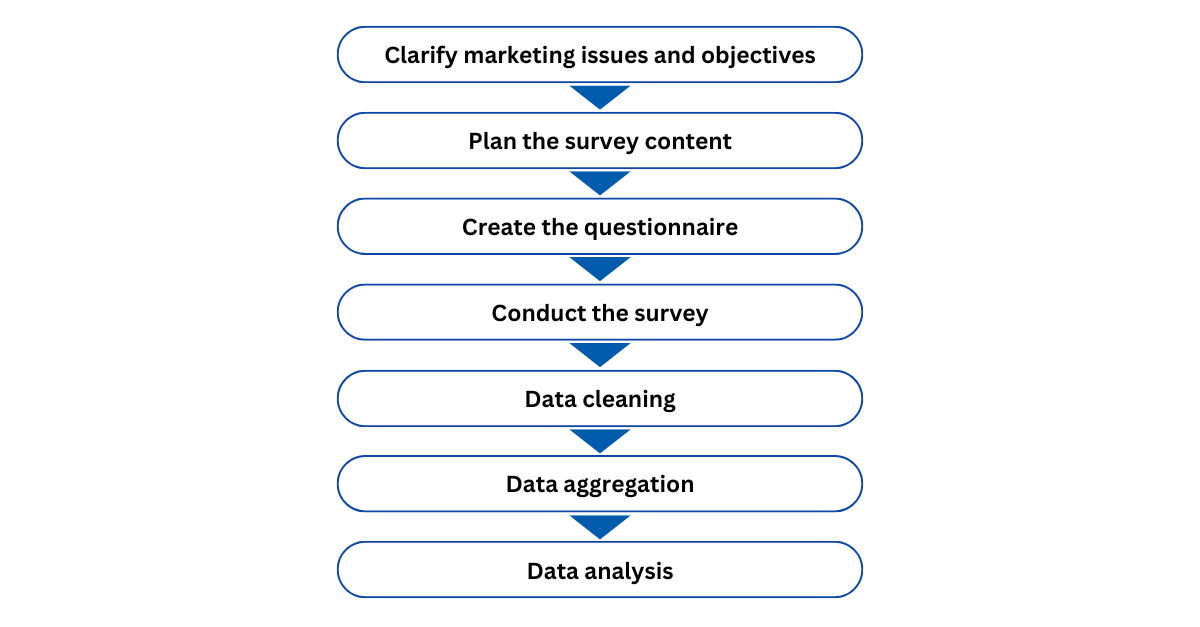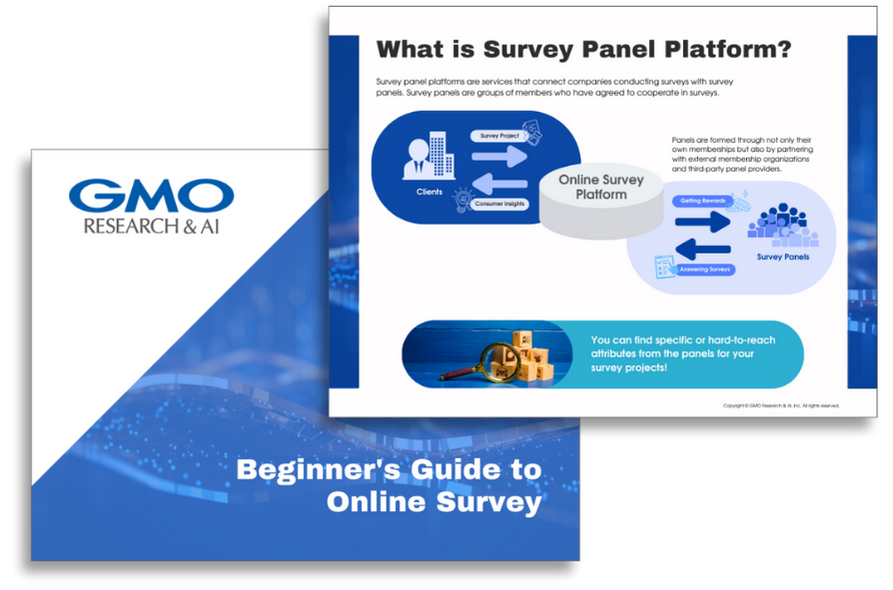Key Points of Survey Design
in Marketing Research
2024/09/05

What is Survey Design?
Conducting marketing research to identify issues and implement appropriate strategies is crucial to effectively addressing company challenges. Survey design is a critical step in conducting marketing research, involving the formulation of a pre-plan that outlines "what the objectives are" and "what kind of research will be conducted." In this article, we will explain key points and specific steps for survey design in marketing research.
Marketing research is generally conducted in follow flow: In the process described above, survey design corresponds to the following two aspects: "Clarify marketing issues and objectives" and "Plan the survey content." The items to organize during survey design phase are as follows:
In the process described above, survey design corresponds to the following two aspects: "Clarify marketing issues and objectives" and "Plan the survey content." The items to organize during survey design phase are as follows:
● Marketing challenges faced by the company
● Selection of target respondents and sample size to obtain the necessary information through surveys
● Costs involved in the overall schedule from preparation to analysis and report creation
● Actions you would take after the survey
7 Steps of Survey Design
The preparation stage, including survey design, is crucial when conducting marketing research.
Thorough preparation is essential to analyze the collected data accurately.
The following seven steps are essential when conducting marketing research:
1. Clarify the marketing issues (Background)
2. Define the research objectives
3. Understand the current situation and set goals
4. Establish hypotheses
5. Anticipate the action that will be taken after the research
6. Select the target audience and research methods
7. Set the budget and schedule (Deadline)
Step 1: Clarify the marketing issues (Background)
Identifying your company’s marketing challenges before designing surveys important.
Marketing challenges may include the following:
● Establishing brand image
● Building customer brand loyalty
● Increasing awareness and positioning of your company’s products or services
● Understanding the market size of your products compared to competitors
By clarifying these challenges, you can determine whether marketing research will effectively solve them.
Additionally, it is essential to identify challenges that cannot be addressed through research data analysis in advance, as some issues may still need to be solved even after the research.
Step 2: Define the research objectives
To solve marketing challenges, you must clearly define the purpose of the research you are to conduct.
If the purpose is unclear, there may be inconsistencies in hypothesis setting and research method selection, which could fail to gather the necessary data. The common objectives are as follows:
● Formulating ideas and understanding market needs for launching new products or services
● Planning proposals and concepts
● Predicting the outcomes of marketing strategies with numerical data
● Identifying challenges in current marketing strategies
● Verifying acceptability of products or services
Step 3: Understand the Current Situation and Set Goals
Consider the “methods to achieve the research objectives.” First, it is crucial to grasp the current state of your company’s products or services, including:
● Awareness of your products or services within the same industry
● Strengths and weaknesses of your products or services compared to competitors
● Purchasing channels and customer demographics for your products
By understanding the current state of your company’s products or services, you can identify gaps between the current situation and your desired objectives, allowing you to determine strategies to bridge that gap.
Step 4: Establish Hypotheses
Formulate hypotheses based on the identified challenges. A hypothesis is a prediction like, "Could X have triggered the phenomenon Y?" Setting a hypothesis helps clarify "who to ask, what to ask, and how to ask," enabling more effective research. Without a hypothesis, marketing research risks collecting irrelevant results or covering too broad a scope, leading to low-quality information that does not contribute to solving the challenges.
Step 5: Anticipate the action that will be taken after the research
The essence of marketing research is to connect the research results to actions such as "strategies for problem-solving," "decision-making," or "new business planning." Therefore, it is essential to consider "the action that will be taken after the research" from survey design stage. To achieve this, determining how to analyze the collected data during survey design phase helps prevent discrepancies between the research objectives and the results.
Step 6: Select the target audience and research methods
After clarifying the marketing challenges and setting the research objectives and hypotheses, the next step is to select the survey target audience and research method. Survey targets are typically selected based on a combination of factors, such as target demographics and experience with using services or products, focusing on "people who can effectively validate the research objectives and hypotheses.
-
Setting the Survey Target
○ Target Attributes: Gender, age, region, occupation, household income, etc
○ Experience in using services/products: Purchase history of products or services, current usage status, etc.
The required sample size (number of responses collected) is determined within a statistically acceptable margin of error. Please refer to the article below for more details on sample size determination.
Questionnaire Sample: Benefits and Effective Survey Sampling Techniques
Determine Sample Size: 4 Essential Steps for Effective Market Research
Step 7: Set the Budget and Schedule (Deadline)
Calculate the research costs and set a schedule that includes the completion date and the timing for decision-making on problem-solving. The costs and duration required for marketing research vary depending on the research method. Some methods require significant preparation time, so be cautious to avoid large discrepancies in the schedule and budget.
Survey Design and Questionnaire Creation
The process of creating survey questions is a crucial factor in achieving the set goals. For more information on how to create an effective questionnaire, please refer to the following article.
Crafting Effective Survey Questionnaires: A Step-by-Step Guide
Crafting Effective Survey Questionnaires: A Step-by-Step Guide Part 2
Paving the Way to Success with Survey Design
You should be aware of many points from survey design stage when conducting marketing research and developing and implementing effective measures. You must construct survey design well to understand your company's appropriate direction. If you need help creating survey design or sampling methods, please contact GMO Research & AI. Our specialized research team will support you.
Beginner's Guide to Successful Online Survey
 |
Using online surveys is a quick and cost-effective way to understand your target consumer and build right strategies. |

